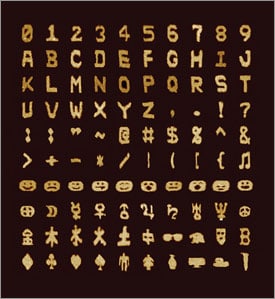
A substantial addition has been made to the toolkit for structural DNA nanotechnology. Currently the only general way to build arbitrarily complex 100-nm-scale DNA objects is scaffolded DNA origami, in which a long (about 7000 bases), biological single stranded DNA molecule is folded into a pre-determined shape through binding to a specially designed set of short, synthetic “staple” strands. A new method now programs self-assembly of arbitrarily complex 150-nm DNA objects from hundreds of distinct single-stranded tiles, each a 42-base strand folded into a 3nm by 7nm tile and attached to four neighboring tiles. With each tile a pixel, the tiles assemble to form a 310-pixel, 150nm-square canvas. A hat tip to ScienceDaily for reprinting this Wyss Institute news release “Wyss Institute Develops New Nanodevice Manufacturing Strategy Using Self-Assembling DNA “Building Blocks”“:
Researchers at the Wyss Institute have developed a method for building complex nanostructures out of short synthetic strands of DNA. Called single-stranded tiles (SSTs), these interlocking DNA “building blocks,” akin to Legos®, can be programmed to assemble themselves into precisely designed shapes, such as letters and emoticons. Further development of the technology could enable the creation of new nanoscale devices, such as those that deliver drugs directly to disease sites.
The technology, which is described in today’s online issue of Nature [abstract], was developed by a research team led by Wyss core faculty member Peng Yin, Ph.D., who is also an Assistant Professor of Systems Biology at Harvard Medical School. Other team members included Wyss Postdoctoral Fellow Bryan Wei, Ph.D., and graduate student Mingjie Dai. …
In focusing on the use of short strands of synthetic DNA and avoiding the long scaffold strand, Yin’s team developed an alternative building method. Each SST is a single, short strand of DNA. One tile will interlock with another tile, if it has a complementary sequence of DNA. If there are no complementary matches, the blocks do not connect. In this way, a collection of tiles can assemble itself into specific, predetermined shapes through a series of interlocking local connections.
In demonstrating the method, the researchers created just over one hundred different designs, including Chinese characters, numbers, and fonts, using hundreds of tiles for a single structure of 100 nanometers (billionths of a meter) in size. The approach is simple, robust, and versatile. …
A short video shows how the single strand tiles assemble to create complex DNA objects.
According to coverage at Physicsworld.com “DNA tiles pave the way“, each shape takes about one hour to produce, compared to a week by the DNA origami technique. In addition it appears to be less expensive since one complete set of tiles costing about £4500 is estimated to be able to make 2 x 1093 possible shapes. With DNA origami a distinct set of staple strands is required for each new shape. On the other hand, yield with the new technique is only 6-40% compared to 95% with DNA origami.
Which technique will prove more convenient for constructing complex systems of molecular machines remains to be seen, but the fact that the new technique is faster and less expensive should speed design-fabricate-test iterations.
—James Lewis, PhD
